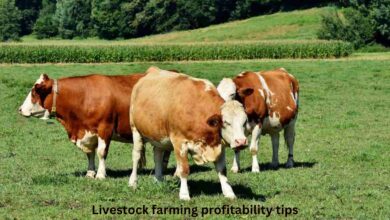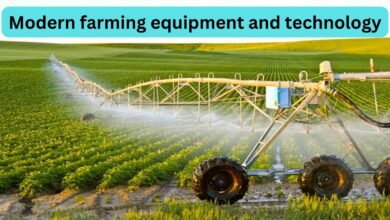Introduction to Farming: A Beginner’s Guide 2024
Farming, one of the oldest professions in the world, remains as essential today as it was thousands of years ago. As our global population continues to grow, the importance of sustainable, efficient farming practices has never been greater. Whether you’re considering farming as a career or simply looking to start a small backyard garden, this beginner’s guide will provide you with the foundational knowledge you need to get started.
Understanding the Basics of Farming
Farming involves cultivating the land to grow crops and raising animals for food, fiber, and other products. It requires a blend of knowledge, skills, and physical labor. Modern farming practices have evolved significantly, incorporating advanced technologies and sustainable methods to increase efficiency and reduce environmental impact.
Types of Farming
There are several types of farming, each with its unique characteristics and requirements. Here are some of the most common:
- Crop Farming: This involves growing various types of crops such as grains, vegetables, fruits, and nuts. Crop farmers focus on soil preparation, planting, irrigation, pest control, and harvesting.
- Livestock Farming: This involves raising animals such as cows, pigs, chickens, and sheep for meat, milk, eggs, and wool. Livestock farmers must manage feeding, breeding, healthcare, and housing for their animals.
- Mixed Farming: This is a combination of crop and livestock farming. It allows farmers to diversify their production and reduce risks associated with market fluctuations and weather conditions.
- Organic Farming: This method avoids synthetic chemicals and GMOs, focusing on natural processes and inputs. Organic farming aims to sustain the health of soils, ecosystems, and people.
- Sustainable Farming: Sustainable farming practices aim to meet current food needs without compromising the ability of future generations to meet theirs. This includes techniques like crop rotation, conservation tillage, and integrated pest management.
Choosing the Right Type of Farming
Before you begin farming, it’s crucial to determine which type of farming best suits your interests, resources, and goals. Consider the following factors:
- Location: The climate, soil type, and available water sources will significantly influence your farming options. Some crops and livestock thrive in specific conditions.
- Market Demand: Research local and global market trends to identify which products are in demand. This can help you decide what to produce and how to price it.
- Resources: Assess your available resources, including land, labor, and capital. Starting small and expanding as you gain experience is often a wise approach.
- Personal Interest: Farming is a demanding and often challenging profession. Choosing a type of farming that aligns with your passion and interests can help sustain your motivation.
Preparing the Soil
Soil health is fundamental to successful farming. Healthy soil provides essential nutrients to plants, retains water effectively, and supports a thriving ecosystem of microorganisms. Here are some steps to prepare your soil:
- Soil Testing: Conduct a soil test to determine its composition, pH level, and nutrient content. This information will guide your soil management practices.
- Soil Amendment: Based on the soil test results, you may need to amend your soil with organic matter, lime, or fertilizers to optimize its fertility.
- Tilling: Tilling the soil helps break up compacted soil, incorporate organic matter, and control weeds. However, excessive tilling can damage soil structure and lead to erosion.
- Mulching: Applying mulch helps retain soil moisture, suppress weeds, and add organic matter as it decomposes.
Selecting the Right Crops
Choosing the right crops is critical for a successful harvest. Consider the following factors when selecting crops:
- Climate: Choose crops that are well-suited to your local climate. Some plants thrive in warm, sunny conditions, while others prefer cooler, shadier environments.
- Soil: Match your crops to your soil type. Some plants require well-drained sandy soil, while others do better in heavier clay soils.
- Market Demand: Grow crops that are in demand in your local market. This increases the likelihood of selling your produce at a good price.
- Crop Rotation: Plan your planting schedule to include crop rotation. Rotating crops helps prevent soil depletion and reduces the risk of pests and diseases.
Planting and Growing Your Crops
Once you’ve prepared your soil and selected your crops, it’s time to plant and nurture them. Follow these steps for successful planting and growing:
- Planting: Plant seeds or seedlings at the appropriate depth and spacing for each crop. Follow the instructions on seed packets or consult gardening guides for specific requirements.
- Watering: Provide consistent moisture to your crops. Avoid overwatering, which can lead to root rot, and underwatering, which can stress the plants.
- Fertilizing: Apply fertilizers as needed to supply essential nutrients. Organic fertilizers like compost and manure are excellent choices for sustainable farming.
- Weeding: Regularly remove weeds that compete with your crops for nutrients and water. Mulching and manual weeding are effective methods.
- Pest Control: Monitor your crops for signs of pests and diseases. Use integrated pest management (IPM) techniques, such as natural predators, traps, and organic pesticides, to control infestations.
Harvesting and Post-Harvest Handling
Harvesting is the culmination of your hard work and requires careful planning and execution to ensure the best quality produce. Follow these tips for a successful harvest:
- Timing: Harvest your crops at the right time to ensure optimal flavor, texture, and nutritional value. Research the best harvest times for each crop.
- Tools: Use the appropriate tools for harvesting to minimize damage to the plants and produce. Sharp knives, shears, and harvest baskets are commonly used.
- Post-Harvest Handling: Properly handle your produce after harvesting to maintain its quality. This includes washing, sorting, packaging, and storing the produce under suitable conditions.
Livestock Farming Basics
If you choose to raise livestock, you’ll need to provide proper care and management to ensure their health and productivity. Here are some key aspects of livestock farming:
- Housing: Provide appropriate shelter for your animals to protect them from extreme weather conditions and predators.
- Feeding: Ensure your livestock receives a balanced diet that meets their nutritional needs. This may include forage, grains, supplements, and clean water.
- Healthcare: Regularly monitor your animals for signs of illness or injury. Establish a relationship with a veterinarian for routine check-ups and vaccinations.
- Breeding: Implement a breeding program to maintain or improve the quality of your livestock. This involves selecting healthy animals with desirable traits for reproduction.
Sustainable Farming Practices
Sustainable farming is essential for preserving the environment and ensuring the long-term viability of agriculture. Here are some sustainable practices to consider:
- Crop Rotation: Rotate crops to maintain soil fertility and reduce pest and disease buildup.
- Conservation Tillage: Minimize soil disturbance to preserve soil structure and reduce erosion.
- Cover Cropping: Plant cover crops to protect and enrich the soil during off-seasons.
- Integrated Pest Management (IPM): Use a combination of biological, cultural, and chemical methods to manage pests in an environmentally friendly manner.
- Water Conservation: Implement efficient irrigation systems and practices to conserve water resources.
Conclusion
Farming is a rewarding and challenging endeavor that requires knowledge, dedication, and hard work. By understanding the basics of farming, selecting the right type of farming, preparing your soil, choosing appropriate crops, and implementing sustainable practices, you can embark on a successful farming journey. Whether you’re starting a small garden or planning a larger agricultural enterprise, this beginner’s guide provides a solid foundation to help you grow and thrive in the world of farming. Happy farming!




